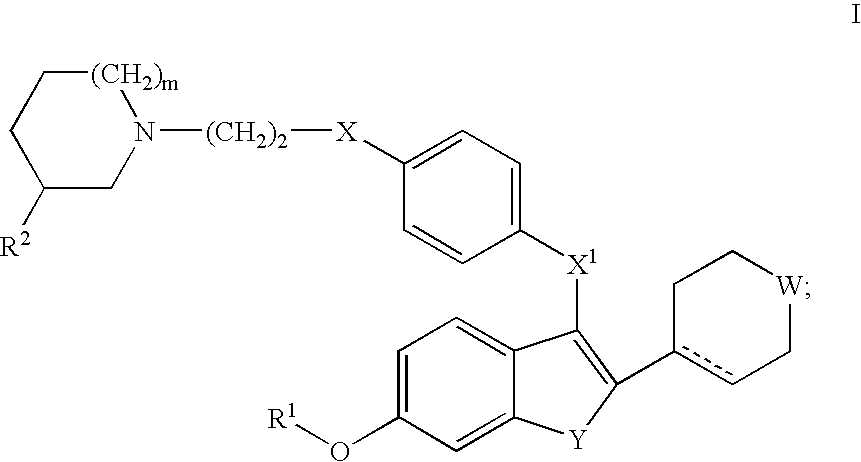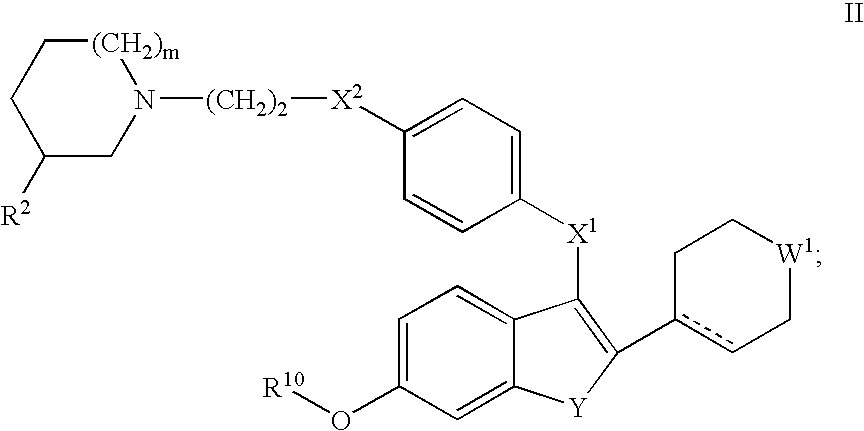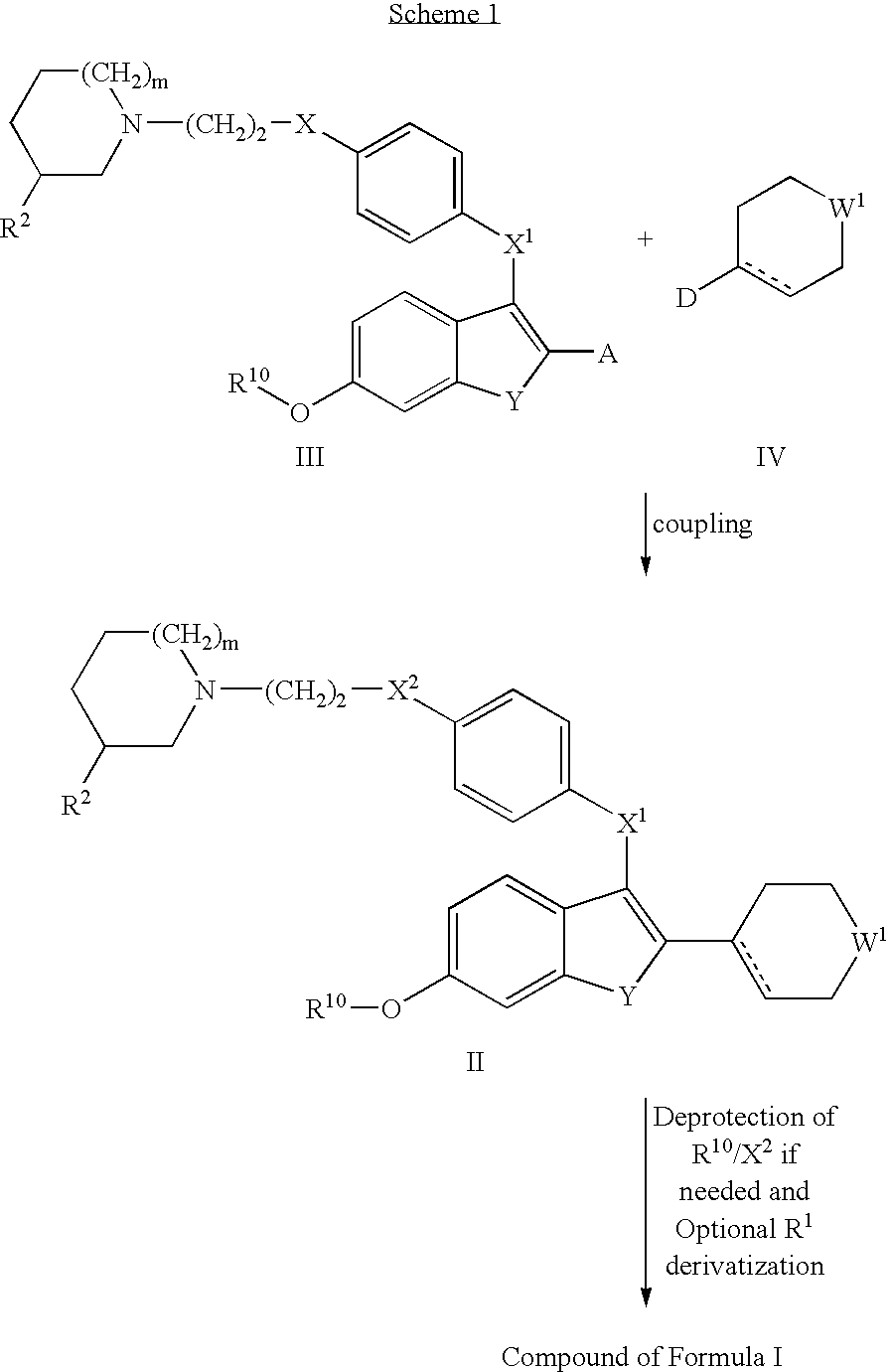Selective estrogen receptor modulators
a technology of estrogen receptor and selective estrogen, applied in the field of medicine, can solve the problems of dysmenorrhea and infertility in women, and the actual use of serm compounds, especially in pre-menopausal women, has been hampered
- Summary
- Abstract
- Description
- Claims
- Application Information
AI Technical Summary
Benefits of technology
Problems solved by technology
Method used
Image
Examples
preparation 1
Trifluoromethanesulfonic acid 6-methoxy-1-[4-(2-piperidin-1-yl-ethoxy)-phenoxy]-naphthalen-2-yl ester
[0071]
[0072] Add 6-methoxynaphthalene-2-ol (20 g, 114.8 mmol) to dimethylformamide (DMF, 250 mL) at ambient temperature followed by N-bromosuccinimide (NBS, 21.5 g, 120 mmol) over a 30-minute period. After 45 minutes, dilute with water (800 mL), collect and dry the precipitate to provide 25.5 g (87%) of 1-bromo-6-methoxy-naphthalen-2-ol.
[0073] Add 1-bromo-6-methoxy-naphthalen-2-ol (66.7 g, 264 mmol), potassium carbonate (K2CO3, 40.0 g, 290 mmol) and benzyl bromide (49.6 g, 290 mmol) to DMF (800 mL). Stir the mixture at ambient temperature for 1 hour. Add water (400 mL) to precipitate the product. Collect the precipitate and wash the filter cake with heptane (3×125 mL) then dry to provide 83.7 g of 2-benzyloxy-1-bromo-6-methoxy-naphthalene (86.2%).
[0074] Combine toluene (200 mL), 2-benzyloxy-1-bromo-6-methoxy-naphthalene (30 g, 87.4 mmol), 4-(2-piperidin-1-yl-ethoxy)phenol (23.2 g,...
preparation 2
(+ / −)-2-(4-Methanesulfonyl-cyclohex-1-enyl)-4,4,5,5-tetramethyl-[1,3,2]dioxaborolane
[0077]
[0078] Combine vinyl sulfone (5 mL, 28.9 mmol), 2-trimethylsilyloxy-butadiene (2.8 g, 31.7 mmol), and toluene (25 mL) in a 50 mL round bottom flask fitted with a reflux condenser. Heat the reaction to reflux for 48 hours. Cool to ambient temperature and concentrate in vacuo. Dilute with dichloromethane (50 mL) and filter through Celite and concentrate in vacuo. Dissolve in methanol (5 mL) and trifluoroacetic acid (2 mL) and stir at ambient temperature for 2 hours. Concentrate in vacuo. Purify the residue by column chromatography using a silica gel column eluting with ethyl acetate. Isolate 1.0 g (26%) of 4-methanesulfonyl-cyclohexanone after concentrating the fractions.
[0079] Combine 4-methanesulfonyl-cyclohexanone (1.0 g, 5.7 mmol), 2,6-di-t-butyl-4-methylpyridine (2.6 g, 12.5 mmol), and dichloromethane (10 mL) in a 25 mL round bottom flask fitted with a reflux condenser. Add triflic anhydri...
example 1
(+ / −)-1-(2-{4-[2-(4-Methanesulfonyl-cyclohex-1-enyl)-6-methoxy-naphthalen-1-yloxy]phenoxy}-ethyl)-piperidine Hydrochloride
[0081]
[0082] Combine trifluoro-methanesulfonic acid 6-methoxy-1-[4-(2-piperidin-1-yl-ethoxy)-phenoxy]-naphthalen-2-yl ester (910 mg, 1.7 mmol) and (+ / −)-2-(4-methanesulfonyl-cyclohex-1-enyl)-4,4,5,5-tetramethyl-[1,3,2]dioxaborolane (990 mg, 3.5 mmol) in acetonitrile (20 mL). Bubble nitrogen through the solution for 10 minutes. Add palladium(II) acetate (39 mgs, 0.2 mmol), tricyclohexylphosphine (0.5 mL, 0.3 mmol, 20% solution in toluene), and cesium fluoride (2.4 g, 15.6 mmol). Fit the flask with a reflux condenser and heat to reflux for 30 minutes. Cool to ambient temperature and dilute with dichloromethane (50 mL) and saturated aqueous ammonium chloride (10 mL). Separate the organic and wash the aqueous twice with dichloromethane (10 mL). Combine the organics and dry over magnesium sulfate. Filter and concentrate in vacuo. Purify the residue by column chromato...
PUM
 Login to view more
Login to view more Abstract
Description
Claims
Application Information
 Login to view more
Login to view more - R&D Engineer
- R&D Manager
- IP Professional
- Industry Leading Data Capabilities
- Powerful AI technology
- Patent DNA Extraction
Browse by: Latest US Patents, China's latest patents, Technical Efficacy Thesaurus, Application Domain, Technology Topic.
© 2024 PatSnap. All rights reserved.Legal|Privacy policy|Modern Slavery Act Transparency Statement|Sitemap



